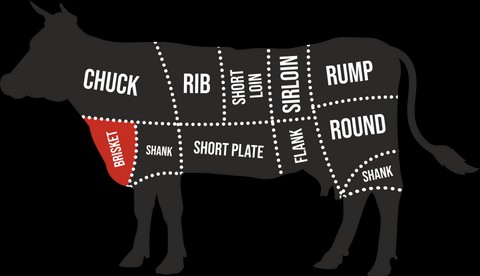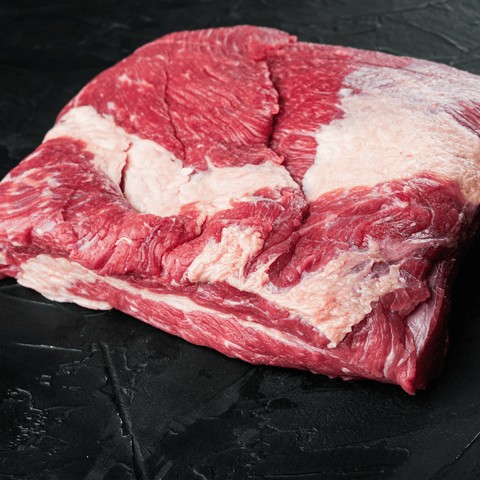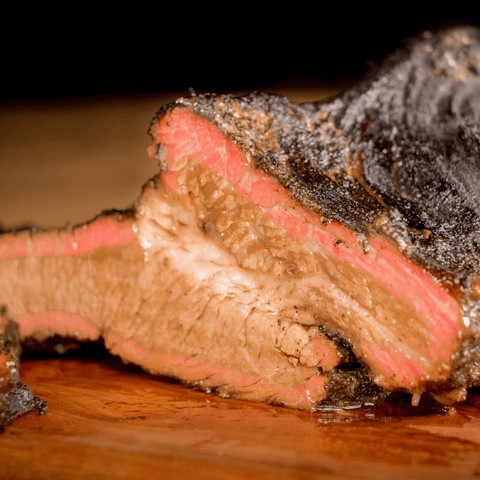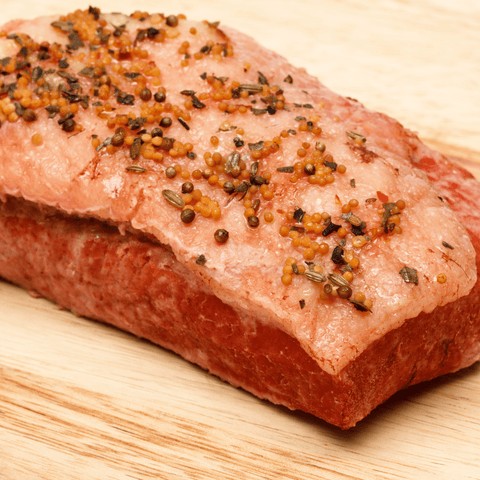What Part Of The Cow Is Brisket? Brisket is a flavorful and popular cut of beef, especially prized for smoking and barbecue, originating from the lower chest of the cow. At WHAT.EDU.VN, we offer expert guidance to help you understand all aspects of beef, including where it comes from, how to prepare it, and how to enjoy the results; explore the location of brisket, its characteristics, and why it’s such a beloved cut and connect with knowledgeable individuals ready to answer your questions freely. Also learn about slow cooking, beefy flavor, and BBQ.
1. Understanding the Brisket: The Basics
Brisket is a cut of beef taken from the breast or lower chest of the cow. Specifically, it’s one of the nine primal cuts of beef. Due to the muscle’s extensive use, it’s a tougher cut, requiring slow cooking to break down the connective tissues and tenderize the meat. This makes it ideal for smoking, braising, and slow cooking methods.
- Primal Cut: One of the primary sections of beef after initial butchering.
- Connective Tissue: Collagen-rich tissue that breaks down during slow cooking, adding moisture and flavor.
2. Anatomical Location of Brisket
Brisket comes from the pectoral muscles of the cow, located between the front legs and below the chuck (shoulder) area. This area supports a significant amount of the animal’s weight, resulting in well-developed muscles and plenty of connective tissue.
- Pectoral Muscles: The muscles in the chest region.
- Chuck: The shoulder area of the cow, adjacent to the brisket.
3. Why Brisket Needs Slow Cooking
The toughness of brisket is due to the high amount of collagen and connective tissues. Slow cooking is essential because it:
- Breaks down collagen: Converts tough collagen into gelatin, making the meat tender.
- Retains moisture: Slow cooking prevents the meat from drying out, keeping it juicy.
- Enhances flavor: Allows the meat to absorb smoky or braising flavors over an extended period.
- Collagen: A protein in connective tissues that becomes gelatin when heated.
- Gelatin: A tender, flavorful substance derived from collagen.
4. The Two Main Parts of Brisket: Point and Flat
A whole brisket consists of two distinct muscles: the point (also known as the deckle) and the flat. Each has its own characteristics and best uses.
4.1. The Flat (First Cut)
The flat is the leaner, more rectangular portion of the brisket. It’s prized for slicing and serving as traditional brisket.
-
Characteristics:
- Uniform thickness
- Less fat compared to the point
- Ideal for slicing
-
Best uses:
- Sliced brisket sandwiches
- Serving as a main course
- Suitable for those who prefer leaner cuts
4.2. The Point (Deckle)
The point is the thicker, fattier section of the brisket. It’s known for its rich flavor and is often used for burnt ends.
-
Characteristics:
- Irregular shape
- Higher fat content
- More marbling
-
Best uses:
- Brisket burnt ends
- Adding flavor to stews and chili
- Shredded brisket
5. Brisket Flavor Profile
Brisket is known for its rich, beefy flavor, which is enhanced by slow cooking and smoking. The fat content and connective tissues contribute to its unique taste and texture.
- Richness: Due to the fat and marbling.
- Beefiness: A deep, savory meat flavor.
- Smokiness: Enhanced by the smoking process, adding layers of flavor.
6. How to Select the Best Brisket
Choosing the right brisket is crucial for a successful cook. Here are some tips:
- Look for Marbling: Marbling refers to the flecks of fat within the muscle. More marbling means more flavor and moisture.
- Check the Fat Cap: A good fat cap (the layer of fat on top) is essential for keeping the brisket moist during cooking. It should be about 1/4 inch thick.
- Choose the Right Size: Consider how many people you’re feeding. A whole packer brisket (both point and flat) can weigh 12-18 pounds.
- Firmness: The brisket should feel firm, not spongy.
- Marbling: Intramuscular fat that enhances flavor and moisture.
- Fat Cap: The layer of fat on top of the brisket.
- Packer Brisket: A whole, untrimmed brisket containing both the point and flat.
7. Trimming Brisket: A Necessary Step
Trimming the brisket involves removing excess fat and silver skin to ensure proper cooking and flavor penetration.
7.1. Why Trim Brisket?
- Even Cooking: Removes thick layers of fat that can prevent even heat distribution.
- Flavor Penetration: Allows seasonings and smoke to penetrate the meat.
- Better Bark: Promotes the formation of a flavorful crust (bark) on the surface.
7.2. How to Trim Brisket
- Remove Hard Fat: Trim away any hard, thick pieces of fat that won’t render during cooking.
- Trim the Fat Cap: Leave about 1/4 inch of fat cap.
- Remove Silver Skin: This tough membrane prevents seasoning from penetrating the meat.
- Silver Skin: A thin, tough membrane on the underside of the brisket.
- Bark: The flavorful crust that forms on the surface of the brisket during smoking.
8. Brisket Preparation Techniques
8.1. Brisket Rubs and Seasonings
A good rub enhances the flavor of the brisket. Common ingredients include:
- Salt and Pepper: A simple yet effective base.
- Garlic Powder: Adds a savory note.
- Onion Powder: Complements the beefy flavor.
- Paprika: Adds color and a hint of sweetness.
- Chili Powder: Provides a touch of heat.
8.2. Brisket Injection
Injecting the brisket with a flavorful liquid can add moisture and enhance the taste. Common injection ingredients include:
-
Beef Broth: Adds a rich, beefy flavor.
-
Worcestershire Sauce: Provides umami and depth.
-
Garlic and Herb Infusions: Adds aromatic complexity.
-
Umami: A savory, meaty flavor.
9. Cooking Methods for Brisket
9.1. Smoking Brisket
Smoking is the most popular method for cooking brisket. It involves cooking the meat low and slow over wood smoke.
- Temperature: 225-250°F (107-121°C).
- Wood: Oak, hickory, and pecan are popular choices.
- Time: 12-18 hours, depending on the size of the brisket.
9.2. Braising Brisket
Braising involves cooking the brisket in a liquid, such as beef broth or wine, in a covered pot or Dutch oven.
- Temperature: 300-325°F (149-163°C).
- Liquid: Enough to cover about two-thirds of the brisket.
- Time: 3-4 hours, or until the brisket is fork-tender.
9.3. Slow Cooking Brisket
Slow cooking in a crock-pot or slow cooker is another option for tenderizing brisket.
- Temperature: Low setting.
- Liquid: Enough to cover the bottom of the slow cooker.
- Time: 8-10 hours.
10. Achieving the Perfect Brisket: Tips and Tricks
10.1. Maintaining Consistent Temperature
Consistent temperature is key to breaking down the connective tissues and achieving a tender result.
- Use a reliable thermometer: Monitor the internal temperature of the smoker or oven.
- Avoid opening the smoker or oven frequently: This can cause temperature fluctuations.
10.2. The Stall
The stall is a phenomenon where the internal temperature of the brisket plateaus for several hours during cooking. It’s caused by evaporative cooling.
- How to overcome the stall:
- The Texas Crutch: Wrap the brisket in butcher paper or aluminum foil to trap moisture and speed up cooking.
- Patience: Simply wait it out. The stall will eventually pass.
10.3. Resting the Brisket
Resting the brisket after cooking allows the juices to redistribute, resulting in a more tender and flavorful product.
-
How to rest:
- Wrap the brisket in butcher paper or foil.
- Place it in a cooler or insulated container.
- Rest for at least 1-2 hours.
-
Texas Crutch: Wrapping the brisket to speed up cooking and retain moisture.
11. Slicing Brisket: The Right Way
Slicing the brisket against the grain is crucial for tenderness.
- Identify the Grain: Look for the direction of the muscle fibers.
- Slice Perpendicular to the Grain: This shortens the muscle fibers, making the meat easier to chew.
- Thickness: Aim for slices about 1/4 inch thick.
12. Brisket Variations Around the World
12.1. Texas-Style Brisket
Known for its simple salt and pepper rub and slow smoking over oak wood.
12.2. Kansas City-Style Brisket
Often includes a sweet and tangy barbecue sauce.
12.3. Jewish Brisket
Typically braised in a sweet and savory sauce with vegetables like carrots and potatoes.
13. Common Mistakes to Avoid When Cooking Brisket
- Not Trimming Enough Fat: Leads to uneven cooking and poor flavor penetration.
- Cooking at Too High a Temperature: Results in tough, dry meat.
- Not Resting the Brisket: Prevents the juices from redistributing, leading to a less tender product.
- Slicing with the Grain: Makes the meat tough and chewy.
14. Health Benefits of Eating Brisket (in Moderation)
Brisket, when consumed in moderation, can offer some nutritional benefits:
- Protein: Essential for muscle building and repair.
- Iron: Important for oxygen transport in the blood.
- Zinc: Supports immune function and cell growth.
- B Vitamins: Help convert food into energy.
15. Brisket and Food Safety
15.1. Safe Handling Practices
- Keep Raw Brisket Separate: Prevent cross-contamination by keeping raw brisket away from other foods.
- Wash Hands Thoroughly: Wash hands with soap and water after handling raw brisket.
- Use Separate Cutting Boards: Use a separate cutting board for raw meat.
15.2. Cooking to the Right Temperature
- Internal Temperature: Cook brisket to an internal temperature of 203°F (95°C) to ensure it’s tender and safe to eat.
- Use a Meat Thermometer: Use a reliable meat thermometer to check the internal temperature.
16. Brisket as a Culinary Delight
Brisket is more than just a cut of meat; it’s a culinary experience. Its rich flavor, tender texture, and versatility make it a favorite among chefs and home cooks alike.
- Versatility: Can be used in a variety of dishes, from sandwiches to stews.
- Flavor: Offers a unique and satisfying taste.
- Experience: Cooking brisket is a rewarding culinary journey.
17. Frequently Asked Questions (FAQs) About Brisket
| Question | Answer |
|---|---|
| What is brisket? | Brisket is a cut of beef from the lower chest of the cow, known for its rich flavor and tough texture, which requires slow cooking to tenderize. |
| Where does brisket come from on the cow? | Brisket comes from the pectoral muscles of the cow, located between the front legs and below the chuck (shoulder) area. |
| Why is brisket so tough? | Brisket is tough due to the high amount of collagen and connective tissues in the muscle. |
| What are the two main parts of brisket? | The two main parts of brisket are the flat (first cut) and the point (deckle). |
| What is the best way to cook brisket? | The best ways to cook brisket are smoking, braising, and slow cooking. Smoking is the most popular method. |
| How do I select the best brisket? | Look for marbling, check the fat cap (about 1/4 inch thick), choose the right size, and ensure the brisket feels firm, not spongy. |
| Why is it important to trim brisket? | Trimming brisket allows for even cooking, better flavor penetration, and the formation of a flavorful bark. |
| What is the ideal internal temperature for cooking brisket? | The ideal internal temperature for cooking brisket is 203°F (95°C). |
| What is the “stall” and how do I overcome it? | The stall is a plateau in the internal temperature of the brisket during cooking. You can overcome it by wrapping the brisket in butcher paper or aluminum foil (the Texas Crutch) or by simply waiting it out. |
| Why is it important to rest brisket after cooking? | Resting brisket allows the juices to redistribute, resulting in a more tender and flavorful product. Rest for at least 1-2 hours. |
| How should brisket be sliced? | Brisket should be sliced against the grain to shorten the muscle fibers and make the meat easier to chew. Aim for slices about 1/4 inch thick. |
| What are some common mistakes to avoid when cooking brisket? | Common mistakes include not trimming enough fat, cooking at too high a temperature, not resting the brisket, and slicing with the grain. |
| What are the health benefits of eating brisket? | Brisket, when consumed in moderation, provides protein, iron, zinc, and B vitamins. |
| How can I ensure brisket is safe to eat? | Keep raw brisket separate from other foods, wash hands thoroughly after handling, use separate cutting boards, and cook to an internal temperature of 203°F (95°C). |
| What are some popular variations of brisket around the world? | Popular variations include Texas-style (salt and pepper rub, smoked over oak), Kansas City-style (sweet and tangy barbecue sauce), and Jewish brisket (braised in a sweet and savory sauce with vegetables). |




18. How WHAT.EDU.VN Can Help You Master Brisket Cooking
At WHAT.EDU.VN, we understand the challenges and questions that come with cooking brisket. That’s why we offer a platform where you can ask any question and receive expert advice and guidance. Whether you’re a beginner or an experienced cook, we’re here to help you master the art of brisket cooking.
- Ask Any Question: Our platform allows you to ask any question about brisket, from selecting the right cut to perfecting your cooking technique.
- Expert Advice: Receive answers from knowledgeable individuals with years of experience in cooking and barbecue.
- Free Service: Our service is completely free, making it accessible to everyone.
19. Conclusion: Enjoying the Art of Brisket
Understanding what part of the cow brisket comes from is just the beginning. Mastering the art of cooking brisket involves selecting the right cut, trimming it properly, using the right seasonings and cooking methods, and avoiding common mistakes. With the right knowledge and techniques, you can create a delicious and memorable brisket that will impress your family and friends.
Brisket, originating from the lower chest, offers a unique blend of flavor and texture, making it a prized cut for various cuisines. At WHAT.EDU.VN, we’re dedicated to providing expert guidance and answering all your questions freely; learn about primal cuts, BBQ techniques, and beefy flavor in detail and if you have any further questions or need personalized advice, don’t hesitate to reach out to us. We’re here to support your culinary journey every step of the way, ensuring you can confidently create mouthwatering brisket dishes. And slow cooking ensures the best results.
Ready to take your brisket cooking to the next level? Do you have burning questions about achieving the perfect smoke ring, mastering the Texas Crutch, or finding the best brisket rub recipe?
Don’t keep your questions to yourself! Visit WHAT.EDU.VN today and ask your question for free. Our community of experts is ready to provide you with the answers you need to create mouthwatering brisket every time.
Address: 888 Question City Plaza, Seattle, WA 98101, United States
Whatsapp: +1 (206) 555-7890
Website: what.edu.vn
